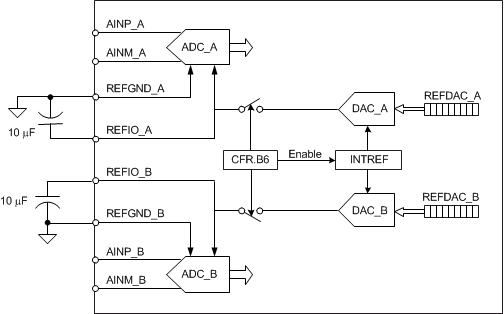ZHCSJ89B January 2019 – July 2022 ADS8353-Q1
PRODUCTION DATA
- 1特性
- 2应用
- 3说明
- 4Revision History
- 5Pin Configuration and Functions
- 6Specifications
- 7Detailed Description
- 8Application and Implementation
- 9Device and Documentation Support
7.3.1 Reference
The device has two simultaneous sampling ADCs (ADC_A and ADC_B). ADC_A and ADC_B operate with reference voltages present on the REFIO_A and REFIO_B pins, respectively. Decouple the REFIO_A and REFIO_B pins with the REFGND_A and REFGND_B pins, respectively, with 10-µF decoupling capacitors.
Figure 7-1 shows that the device supports operation either with an internal or external reference source. The reference voltage source is determined by setting bit 6 of the configuration register (CFR.B6). This bit is common to ADC_A and ADC_B.
 Figure 7-1 Reference Configurations and Connections
Figure 7-1 Reference Configurations and ConnectionsWhen CFR.B6 is 0, the device shuts down the internal reference source (INTREF) and ADC_A and ADC_B operate on external reference voltages provided by the user on the REFIO_A and REFIO_B pins, respectively.
When CFR.B6 is 1, the device operates with the internal reference source (INTREF) connected to REFIO_A and REFIO_B via DAC_A and DAC_B, respectively. In this configuration, VREF_A and VREF_B can be changed independently by writing to the respective user-programmable registers, REFDAC_A and REFDAC_B, respectively. See the Section 7.6 section for more details.